
The Chevrolet Suburban
The Suburban wasn’t just a significant model for Chevrolet, it was an important vehicle for the car industry as a whole. Arguably it was the first Sport Utility Vehicles (SUV), a tough, no-nonsense load carrier featuring a station wagon body on the chassis of a small truck. Actually christened the Suburban Carryall – for it could pretty much carry anything – its origins could be traced back to 1933 and a wooden eight-seater body on half ton truck frame, intended for National Guard and Civilian Conservation Corps units. When made available to the public, it gained an all-metal body fitted with either rear panel doors or a tailgate. “They were doing a crossover between a car and a truck,” says Ed of the vehicle that gave birth to what is now the longest continuous name to be used on a car. “And it’s got a cool interior, too, a real neat one. One might consider it the first crossover, and it’s very much related to the Captiva.”
Chevrolet introduced in 1936 the “Suburban”, a vehicle that fundamentally changed the automobile market. With a focus on functionality, the credo of the new concept was “to carry all”. At long last, the whole family was to find sufficient space in one car – and preferably the fishing equipment too. To build this automobile, Knudsen’s engineers used a conventional truck chassis, but instead of installing a loading floor, as in the case of pick-ups, they had designed a generous passenger compartment in which up to 8 persons found sufficient seating space on three rows of seats. A sound 90 horse- power engine provided the necessary power, and the world’s first station wagon was born. The “Suburban” had changed only very little by the time production was stopped in World War II. After the war , the “Suburban” underwent continuous improvements.
In 1955, the basic model was delivered with a 100 horse-power engine, and in 1956 a V8 became the standard. In 1957, the “Suburban” was available for the first time with 4-wheel drive, which made it a truly practical vehicle. It was no longer defined a station wagon, but a car, and as such the prototype of the SUVs seen on our roads today.

1935 Chevrolet Suburban
1935: Suburban Carryall introduced with a signature two-door body style that would last through 1967. Power came from Chevrolet’s stalwart “Stovebolt” inline-six that produced 60 horsepower (45 kW) for the half-ton chassis.
The idea for the Suburban was born out of a need for a heavier-duty, truck-based wagon. Through the early 1930s, most manufacturers offered car-based wagons for professional use. Open models with windows and rear seating were known as depot hacks, and were used to ferry passengers and their cargo around train stations and boat docks. Enclosed models, typically without rear seats, were known as sedan deliveries.
Bodywork for these early vehicles often consisted of wood sides and canvas tops; and while they were versatile, their car-based chassis and damage-prone bodies were compromises. Chevrolet began experimenting with an all-steel wagon body mounted on a commercial chassis in the mid-1930s, and the Suburban Carryall was launched in 1935.
The base price of the original, eight-passenger Suburban was about $675, or the equivalent of about $10,900 in 2010 dollars, a radio, heater, clock and even a rear bumper were extra-cost options. It might well have been called a sport utilitarian vehicle.
The original Suburban could seat eight, while easily removable seats provided a large, 75-inch-long by 77-inch-high (1,905 x 1,956 mm) cargo area. The 2010 Suburban seats up to nine, but offers up to 137.4 cubic feet (3,891 L) of cargo space when the second-row seats are folded and third-row seats are removed.

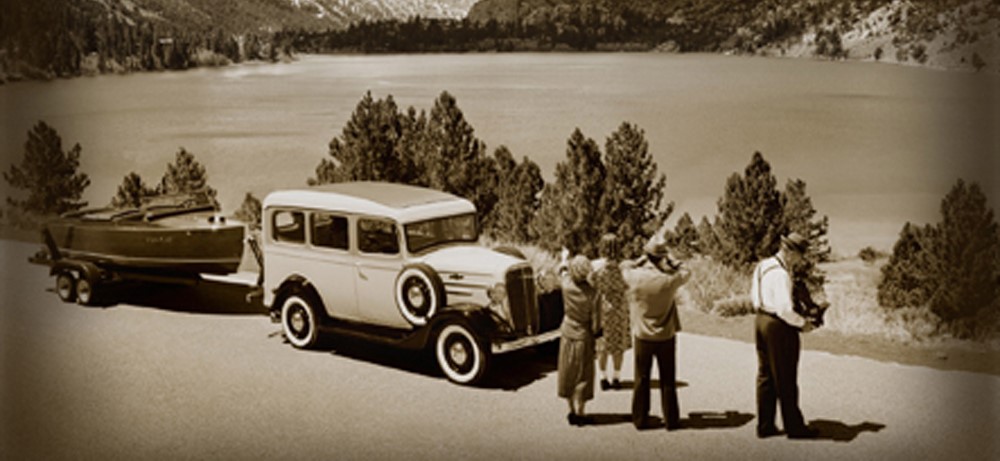

1936 Chevrolet Suburban
- 1936: Hydraulic brakes introduced.
The Chevrolet Suburban was launched during the Great Depression and in its second model year, it faced a market where unemployment was nearly 17 percent. President Franklin D. Roosevelt was reelected in a classic landslide. His New Deal programs were still winding their way through Congress, but two of them – Social Security and unemployment benefits – were enacted and already proving popular with voters. Roosevelt carried nearly 99 percent of the Electoral College votes and about 61 percent of the popular vote.
There were glimmers of hope in the 1936 economy, which were reflected in the approximate 21-percent increase in Chevrolet truck sales versus the previous year. The Suburban accounted for a significant portion of those greater sales, as customers found its eight-passenger, wagon-style configuration ideal for ferrying passengers and work crews. The Suburban was a commercially oriented vehicle and wasn’t marketed to “civilian” customers.
The Suburban changed little from its inaugural model year in 1935. It was still based on Chevrolet’s half-ton truck chassis, including a 112-inch wheelbase. Upgrades in the second year included the addition of hydraulic brakes, which enhanced safety, while changes to the engine brought about 30 percent more horsepower. But it was still a commercial vehicle, after all, and features including a radio, clock, heater and dual windshield wipers were available only as options.
Power for the ’36 Suburban came from Chevrolet’s durable inline-six engine that was affectionately known as the Stovebolt engine – a nickname derived from the large, slotted-head fasteners in the engine that resembled those in popular wood-burning stoves. The Stovebolt displaced 207 cubic inches (3.4L), but the changes in 1936 brought a higher compression ratio and a new, better-performing carburetor. Horsepower increased from 60 in 1935 to 79.
1936 CHEVROLET SUBURBAN FACTS
Body style……………………………………………………..Two-door with tailgate
Wheelbase…………………………………………………….112 inches
Engine………………………………………………………….207-cubic-inch (3.4L) I-6
Horsepower……………………………………………………79 at 3,200 rpm
Torque (approx.)……………………………………………..140 lb.-ft. at 1,000-2,000 rpm
Transmission…………………………………………………..Three-speed manual
Curb weight (approx.)………………………………………..3,300 pounds
THE BOTTOM LINE: 1936 INCOME AND PRICES (with 2010 inflation conversions)
Chevrolet Suburban (base MSRP)…………………………..$685 ($10,743)
Median household income……………………………………$1,600 ($25,095)
Median house price…………………………………………..$6,200 ($97,242)
Cost of a gallon of regular gasoline…………………………$0.19 ($2.98)
Cost of a loaf of bread……………………………………….$0.08 ($1.25)
Cost of a movie ticket……………………………………….$0.24 ($3.76)
Average Major League Baseball salary……………………..$2,700 ($42,347)
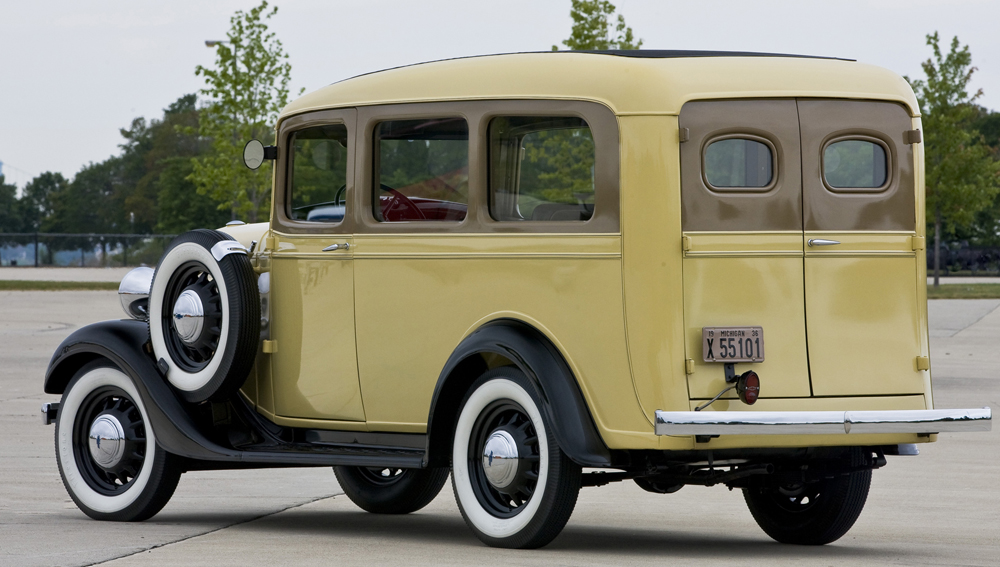
- 1937: New, streamlined exterior styling carried Art Deco cues, and horsepower from the Stovebolt six increased to 79 (59 kW). NEW TECHNOLOGY: Safety glass is introduced.
- 1940: Sealed beam headlights debut, offering significantly improved visibility when driving at night.
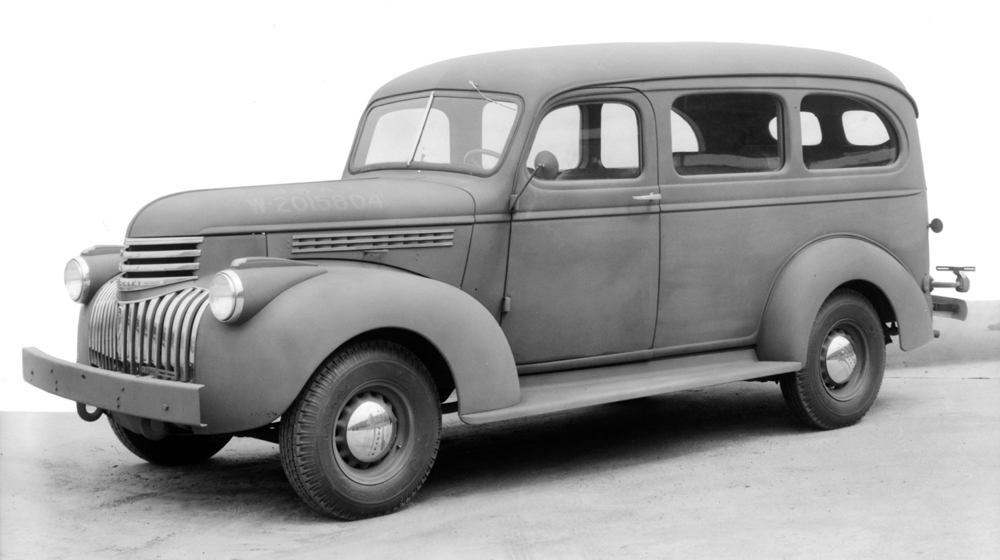
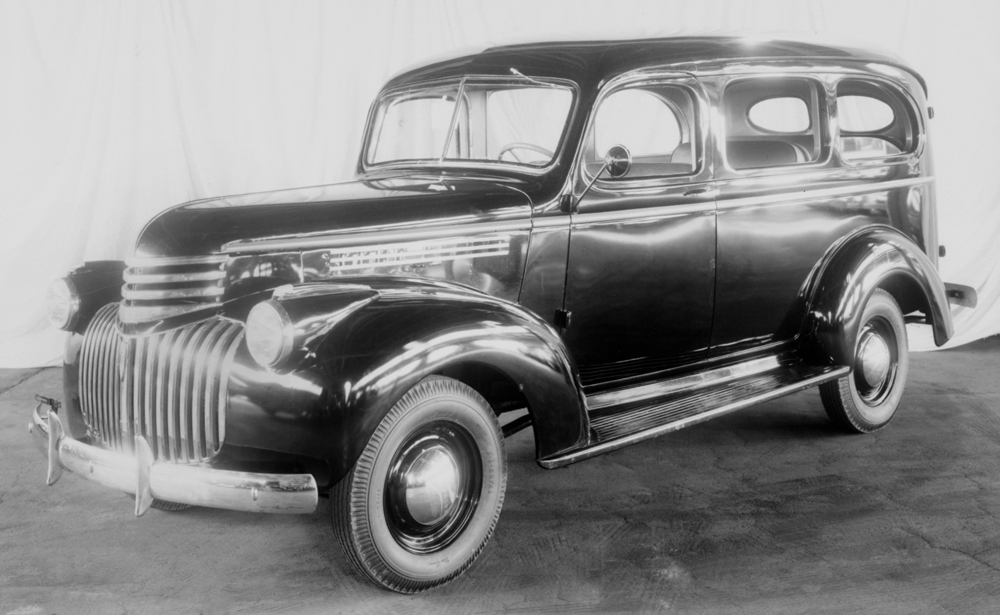

1946 Chevrolet Suburban
There was national euphoria at the end of World War II, but confusion, too. Returning G.I.s came home to an America that had essentially gone on hold since 1942. When the country put itself collectively behind the war effort, discretionary purchases all but dried up and the manufacture of durable goods mostly ceased as factories converted to the production of war materials.
The auto industry led the conversion to war production and virtually no cars or light-duty trucks were produced for civilian use between early 1942 and late 1945. And because the end of the war was difficult to predict, when the factories finally switched back from bombers to passenger vehicles, there were no new models on the drawing boards. All the major automakers basically picked up in 1946 where they left off with the 1942 models.
Chevrolet’s truck line exemplified the state of the industry in ’46. The exterior styling of the Suburban was the same as the brief 1942 model run. In fact, early production of the 1946 models was virtually identical to the ’42 models, including a lack of war-rationed chrome trim. Later in 1946, bright trim reappeared and other refinements were added to the Suburban.
The stalwart Stovebolt-six engine was the engine that powered the ’46 Suburban. It produced 90 horsepower and plenty of low-rpm torque that made the Suburban great for hauling people and cargo. The engine was backed by a three-speed manual transmission and hydraulic brakes were standard.
To satisfy pent-up demand for new vehicles and allow final validation of the next generation, production of the 1946 Suburban (and all other Chevrolet trucks) lasted through May 1947.
1946 CHEVROLET SUBURBAN FACTS
Body style…………………………………………………….Two-door with tailgate or “barn doors”
Wheelbase…………………………………………………….115 inches
Engine………………………………………………………….216.5-cubic-inch (3.8L) I-6
Horsepower……………………………………………………90 at 3,300 rpm
Torque (approx.)……………………………………………..165 lb.-ft. at 1,000-2,000 rpm
Transmission……………………………………………………Three-speed manual
Curb weight (approx.)………………………………………..3,400 pounds
THE BOTTOM LINE: 1946 INCOME AND PRICES (with 2010 inflation conversions)
Chevrolet Suburban(base MSRP)……………………………$1,283 ($14,344)
Median household income……………………………………$2,500 ($27,950)
Median house price…………………………………………..$5,600 ($62,608)
Cost of a gallon of regular gasoline…………………………$0.21 ($2.35)
Cost of a loaf of bread……………………………………….$0.10 ($1.12)
Cost of a movie ticket……………………………………….$0.35 ($3.91)
Average Major League Baseball salary……………………..$4,500 ($50,310)
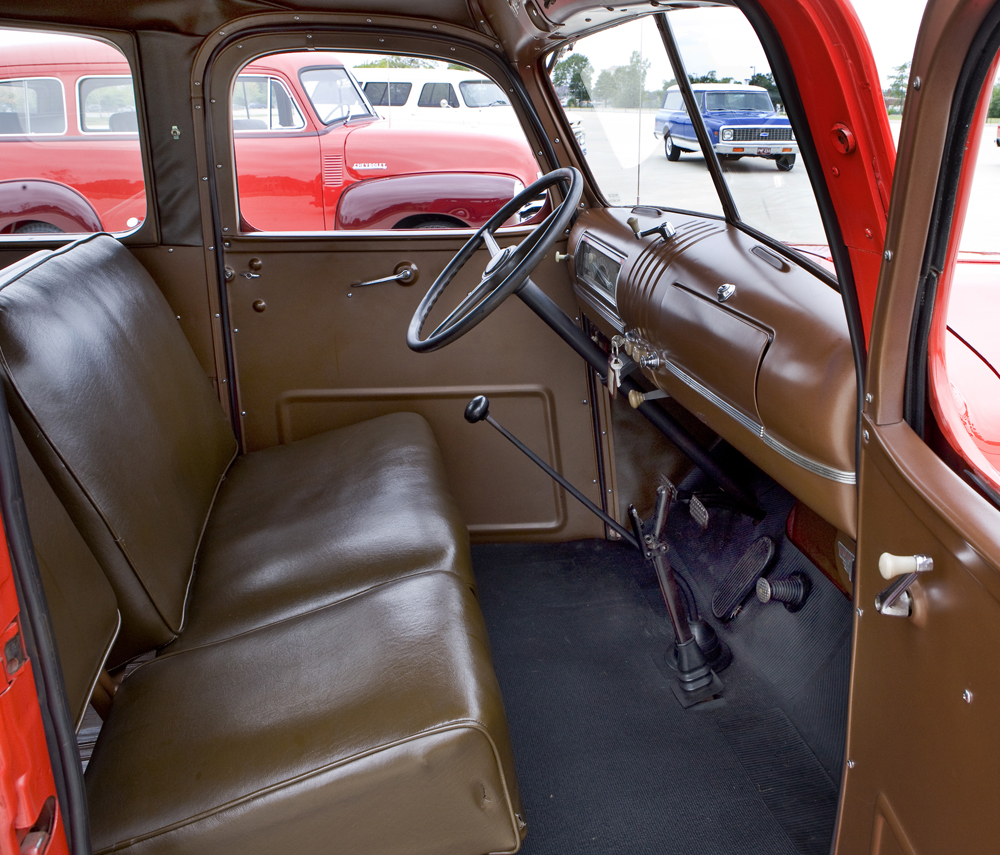
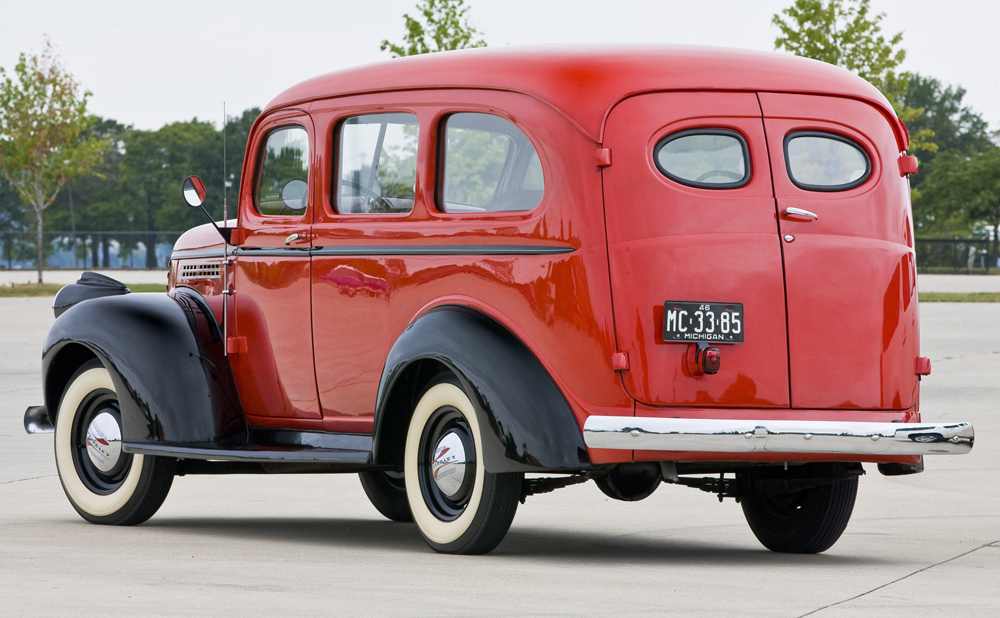
- 1947: The first significant redesign of the Chevrolet’s truck line – including Suburban – since before the war. Torque from the inline-six engine was 174 lb.-ft. (217 Nm) at only 1,200 rpm, giving the Suburban excellent towing capability. NEW TECHNOLOGY: Flow-through ventilation improves driving comfort.
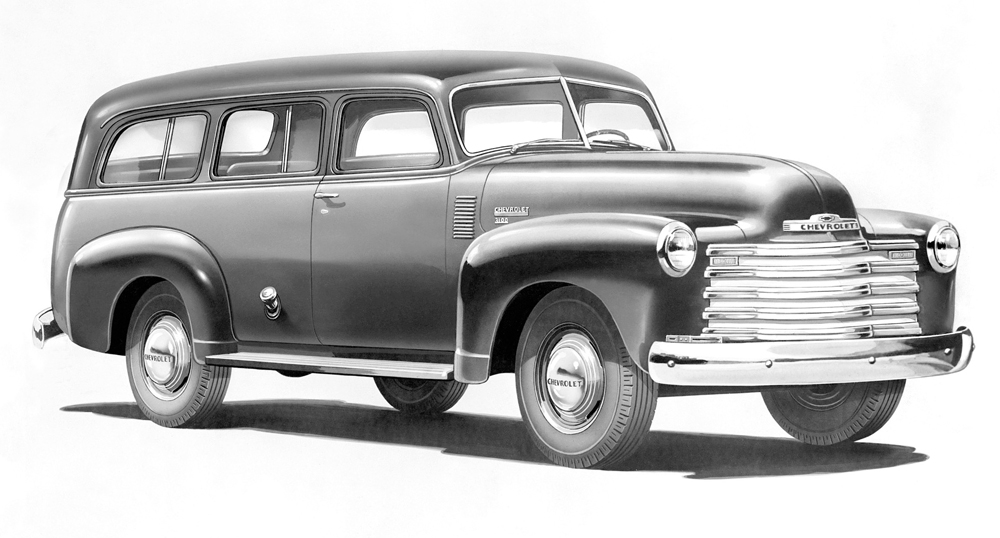
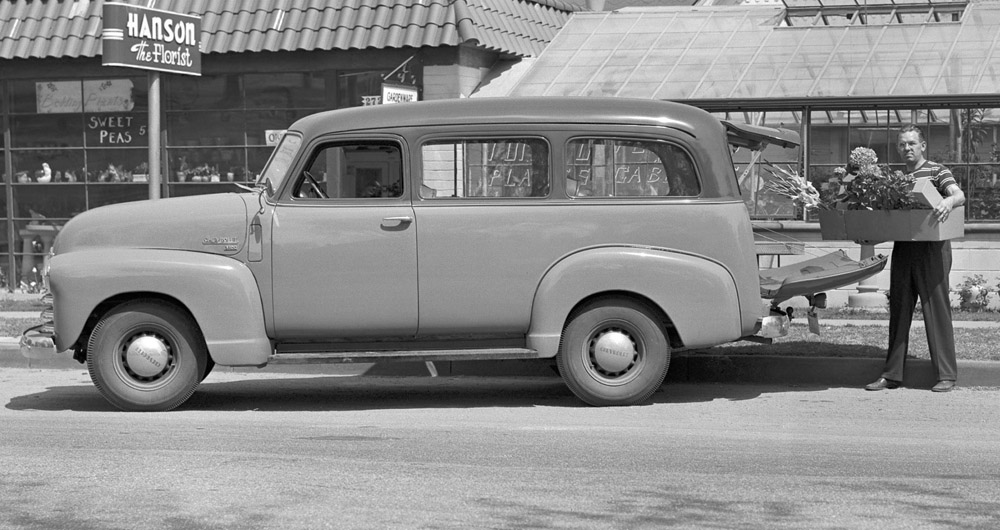
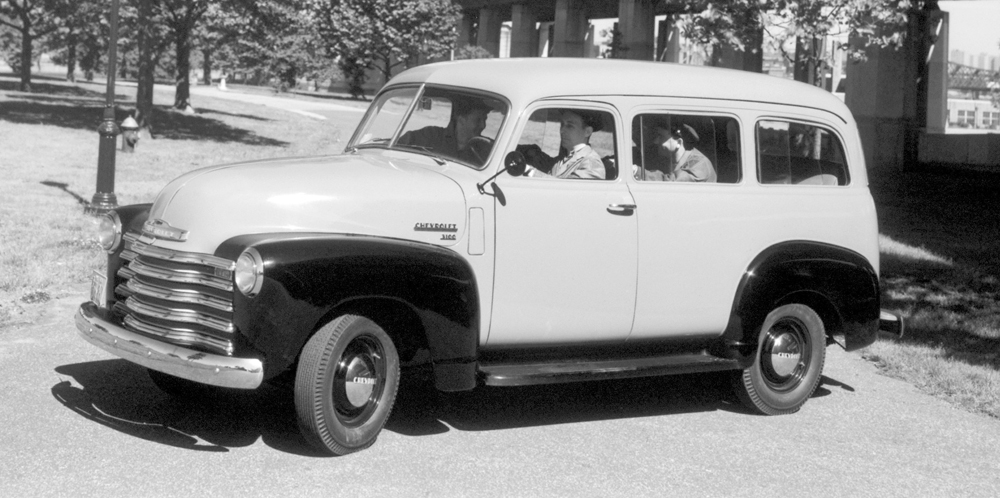
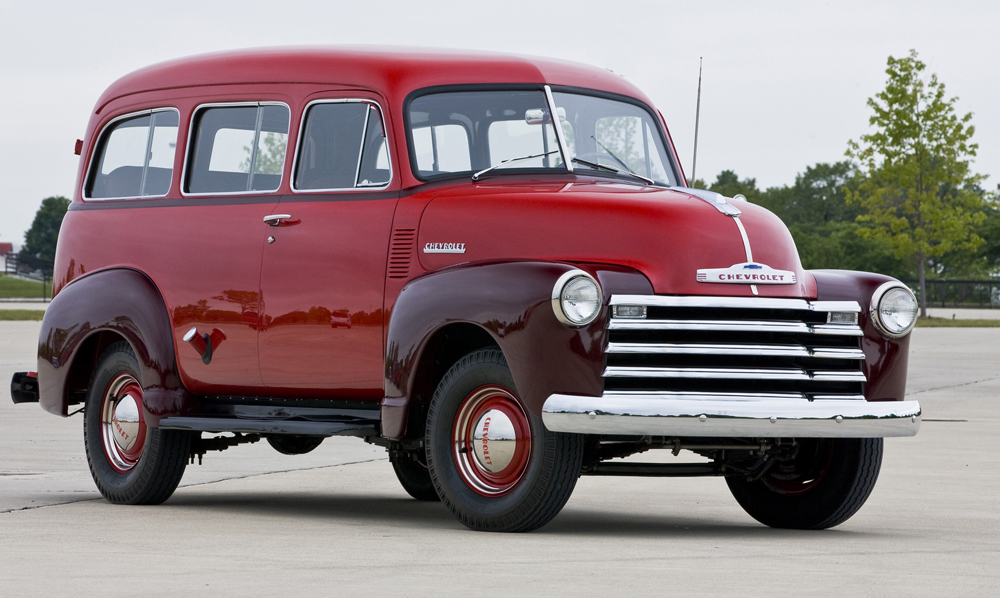
1951 Chevrolet Suburban
The Chevrolet Suburban had already been on the market for 16 years in 1951 and continued to grow in popularity as a “crew” vehicle for transporting workers to construction and logging sites.
The ’51 Suburban carried the basic design that had been introduced on the Chevy truck line in 1948. It was a sleek design, with a sloping windshield and simple yet bold horizontal grille bars. Many promotional photos and catalogs from 1951 show the trucks with shiny chrome grilles, but material shortages due to the Korean War meant most Suburbans left the factory with painted grilles.
As it had since its 1935 introduction, the 1951 Suburban offered seating for up to eight in a two-door body style. The rear cargo area was accessible by either a tailgate or a pair of side-opening “barn doors.” The second- and third-row seats were removable and they were mounted on a linoleum-covered floor. “Double-acting” shock absorbers were touted as main contributors to the vehicle’s “superb riding comfort.”
Under the hood of the ’51 Suburban was the “Thriftmaster” inline six-cylinder engine. It was the latest version of the cast iron workhorse commonly called the “Stovebolt” engine that dated from before the Suburban’s 1935 introduction. With a 216.5-inch (3.8L) displacement, it produced 92 horsepower. More importantly, it delivered 176 lb.-ft. of torque between 1,000 and 2,000 rpm. That meant the engine’s peak torque was available essentially off idle through the majority of the rpm range, giving the Suburban a strong feeling of acceleration and great towing capacity.
1951 CHEVROLET SUBURBAN FACTS
Body style……………………………………………………..Two-door with tailgate or “barn doors”
Wheelbase……………………………………………………..116 inches
Engine………………………………………………………….216.5-cubic-inch (3.8L) I-6
Horsepower……………………………………………………92 at 3,400 rpm
Torque………………………………………………………….176 lb.-ft. at 1,000-2,000 rpm
Transmission…………………………………………………..Three-speed manual
Curb weight (approx.)……………………………………….3,640 pounds
THE BOTTOM LINE: 1951 INCOME AND PRICES (with 2010 inflation conversions)
Chevrolet Suburban (base MSRP)…………………………..$1,818 ($15,700)
Median household income…………………………………….$3,000 ($25,913)
Median house price…………………………………………..$7,500 ($64,784)
Cost of a gallon of regular gasoline…………………………$0.16 ($1.38)
Cost of a loaf of bread……………………………………….$0.16 ($1.38)
Cost of a movie ticket……………………………………….$0.45 ($3.89)
Average Major League Baseball salary……………………..$7,500 ($62,877)
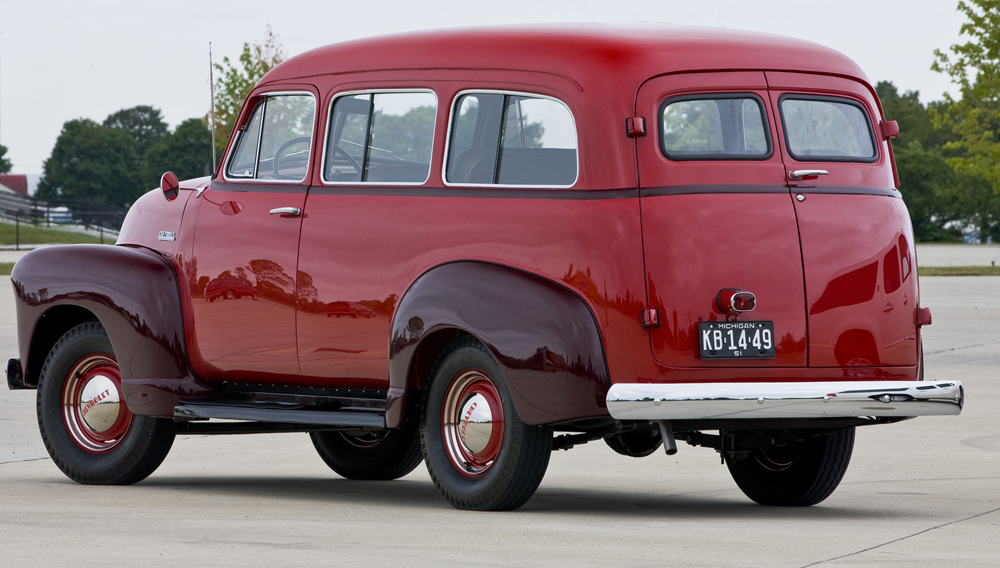
- 1953: Tinted glass is offered for the first time.
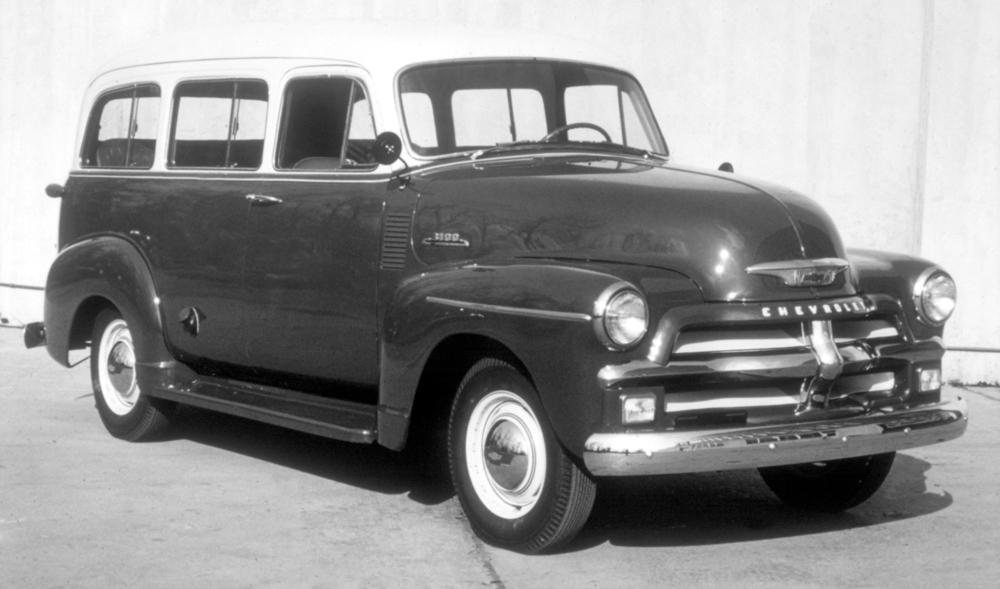
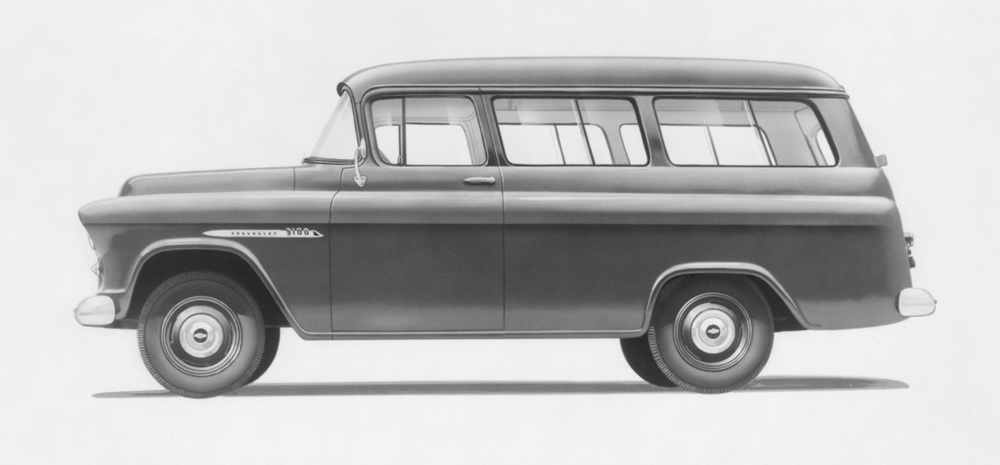
- 1955: Revolutionary new styling is introduced midway through the model year. Known as the “second series” design, it features a wraparound windshield and the elimination of running boards – the body is flush with the fenders for the first time. The second series model also introduces the ubiquitous small-block V-8. NEW TECHNOLOGY:
- Hydra-Matic automatic transmission
- 12-volt electrical system
- Tubeless tires.
- 1957: Factory-installed four-wheel drive is offered for the first time, with the famous NAPCO-supplied “Powr-Pak” system.
- 1959: Positraction rear axle introduced. positraction directs power to the wheel that needs it most. If you drive in normal conditions on a road or highway, the differential will provide equal torque to both wheels. This helps to smooth out vehicle movement and is useful in most driving situations you may find yourself in.

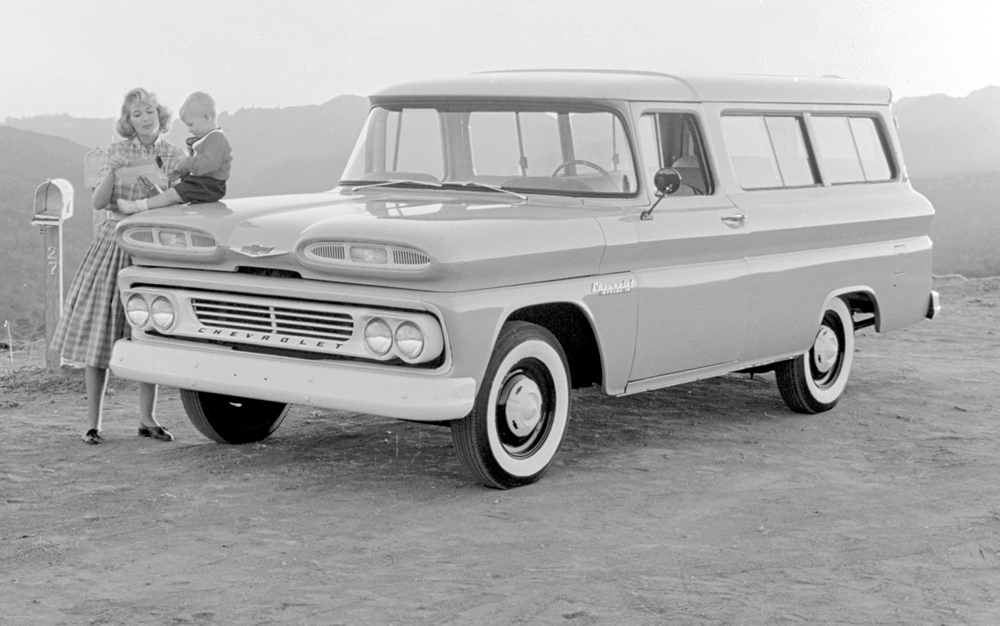
- 1960: Chevrolet institutes the C/K designations to denote models with 2WD (C) and 4WD (K). Front-end styling is also new. NEW TECHNOLOGY: Independent front suspension (torsion bars) is introduced.
- 1963: Stronger, ladder-type frame design debuts.
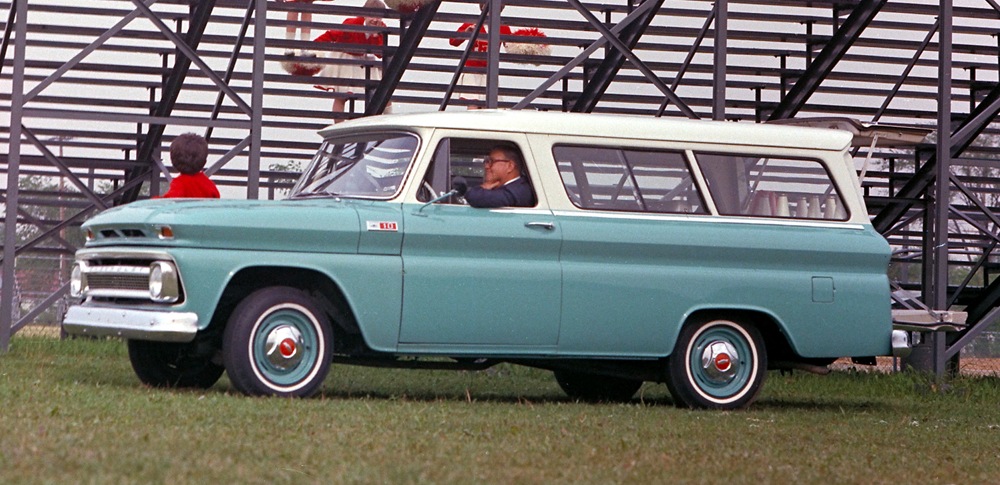
- 1965: Factory-installed air conditioning and rear-area heater offered for the first time.


1966 Chevrolet Suburban
By the mid-Sixties, America’s suburban culture was firmly in place and the national population was approaching 200 million. Cultural changes were happening in all areas, from a growing counter-culture among young Baby Boomers to technologies such as artificial turf for sports fields. AstroTurf was installed for the first time in 1966, at the Houston Astrodome, ushering in an era of sports domes built not in urban centers, but the suburbs. It was also the year “Star Trek” debuted on television.
Already in production for more than 30 years, the 1966 Chevrolet Suburban was in its final year of a design generation that brought greater passenger comfort, amenities and safety features – although a deluxe heater was still a $53 option. The Suburban was offered in a half-ton chassis, with 2WD or 4WD, but it was still used primarily as a crew hauler and fewer than 1,000 of the approximately 13,000 examples sold that year were ordered with 4WD.
Power for the ’66 Suburban came in either inline-6 or V-8 forms, with the standard 230-cubic-inch six-cylinder a more modern descendent of the “Stove Bolt” six that was offered in the Suburban when it was introduced. It was renowned for its durability and over the years had cultivated a loyal following among truck customers. Also available were two versions of classic small-block V-8: a 283-cubic-inch engine rated at 175 horsepower and a 327-inch engine rated at 220 horsepower.
An increasing call for greater safety in passenger vehicles saw the inclusion of safety belts, back-up lights and dual-speed windshield wipers as standard equipment in the Suburban for the first time. New safety equipment would be included on the next-generation model.
After more than 30 years on the market, the 1966 Suburban remained a utilitarian transporter with room for many passengers, their cargo and excellent towing capability. It was a combination that more and more “civilian” customers were finding enticing to support leisure activities such as boating, camping and auto racing.
1966 CHEVROLET SUBURBAN FACTS
Body style……………………………………………………..Two-door with tailgate or “barn doors”
Wheelbase…………………………………………………….115 inches
Engine………………………………………………………….283-cubic-inch (4.6L) V-8
Horsepower……………………………………………………175 at 4,400 rpm
Torque…………………………………………………………275 lb.-ft. at 2,400 rpm
Transmission…………………………………………………..Three-speed manual
Curb weight (approx.)………………………………………..3,710 pounds (2WD)
THE BOTTOM LINE: 1966 INCOME AND PRICES (with 2010 inflation conversions)
Chevrolet Suburban (base MSRP)…………………………..$2,598 ($17,642)
Median household income……………………………………$7,400 ($50,252)
Median house price…………………………………………..$21,400 ($145,324)
Cost of a gallon of regular gasoline…………………………$0.23 ($1.56)
Cost of a loaf of bread……………………………………….$0.25 ($1.70)
Cost of a movie ticket……………………………………….$1.20 ($8.15)
Average Major League Baseball salary……………………..$17,664 ($119,953)
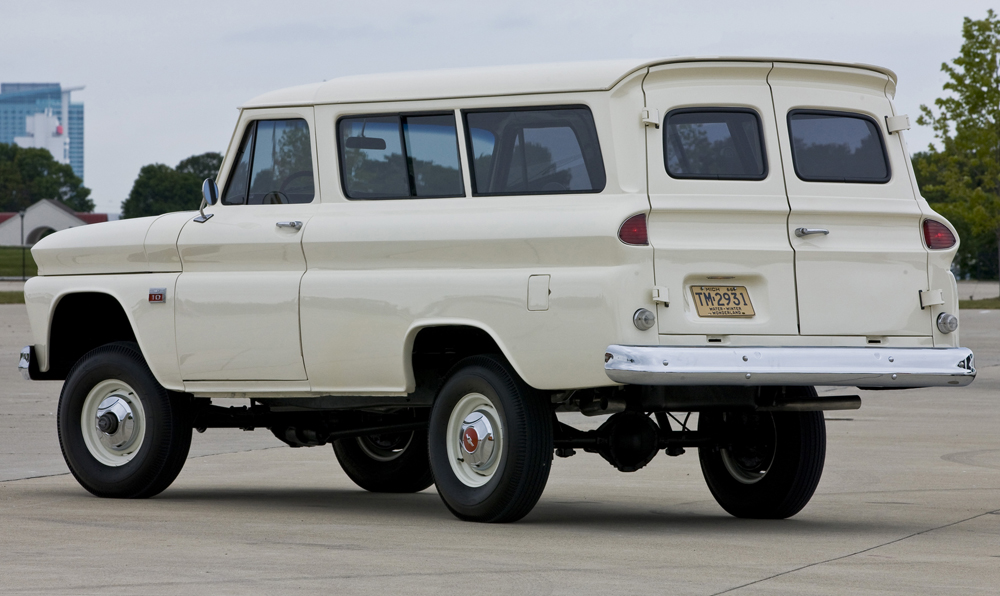
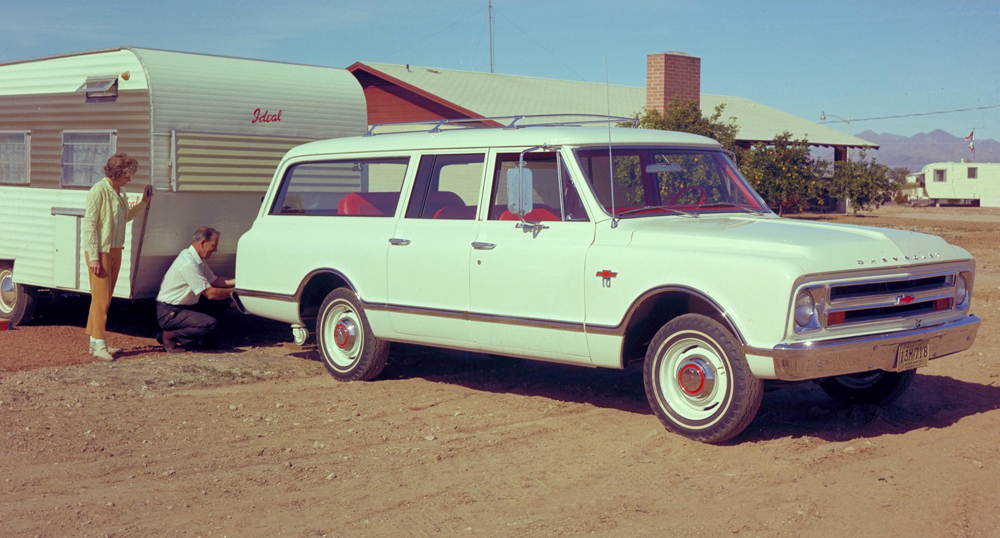
1967: All-new styling of Chevy’s half-ton trucks is introduced, including Suburban. It carries a unique three-door arrangement with a single door on the driver’s side and front and rear doors on the passenger side. This configuration makes the Suburban popular with ambulance companies. A host of new safety features becomes standard, including:
- Dual-cylinder brake system
- Energy-absorbing steering column
- Padded instrument panel
- Thicker laminated safety glass windshield.

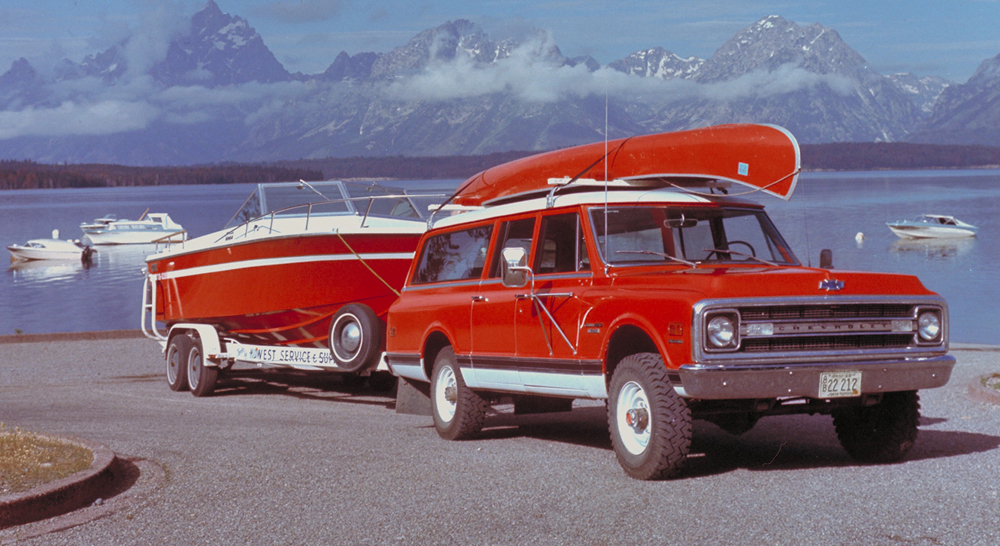
- 1971: Standard front disc brakes and engines tuned to run on unleaded gas.
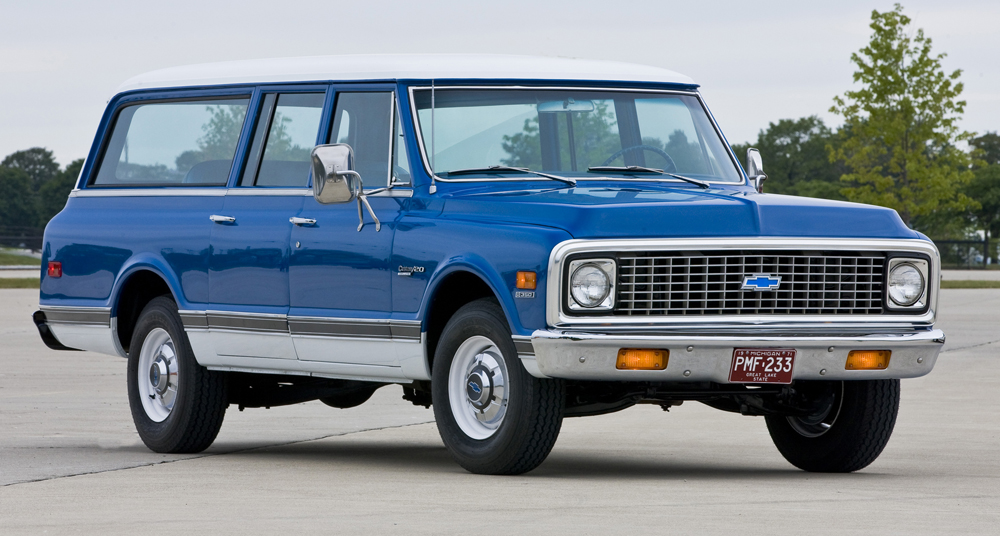
1972 Chevrolet Suburban
The ’72 Suburban was the final model of a unique three-door design that was introduced in 1967. It featured a single door on the driver’s side and a pair of doors on the passenger side. That transformative generation for the Suburban introduced a longer, 127-inch wheelbase, which significantly increased its cargo-hauling capability and enhanced its towing capacity. It was also the generation that launched the heavy-duty three-quarter-ton chassis.
Signaling the future of SUVs, sales numbers for Suburbans grew dramatically during the ’67-72 era, from about 6,200 in 1967 to more than 27,000 in 1972 – an increase of nearly 450 percent. The number of Suburbans ordered with 4WD increased significantly during those years, too. Only 166 half-ton models were built with it and a mere 120 three-quarter-ton examples left the factory with it in 1967, but those numbers grew to more than 3,000 half-tons and nearly 1,400 three-quarter-ton models in 1972.
Standard equipment included standard front disc brakes (introduced in 1971), while power steering and power interior accessories were optional. An inline-6 was remained the standard engine, while several small-block V-8s and a 402-inch big-block engine were available.
1972 CHEVROLET SUBURBAN FACTS
Body style……………………………………………………..Three-door with “barn doors”
Wheelbase……………………………………………………..127 inches
Engine………………………………………………………….350-cubic-inch (5.7L) V-8
Horsepower……………………………………………………75 at 3,600 rpm
Torque…………………………………………………………350 lb.-ft. at 3,000 rpm
Transmission…………………………………………………..Three-speed automatic
Curb weight (approx.)………………………………………..3,870 pounds (2WD half-ton)
THE BOTTOM LINE: 1972 INCOME AND PRICES (with 2010 inflation conversions)
Chevrolet Suburban (base MSRP)…………………………..$3,495 ($18,363)
Median household income……………………………………$11,120 ($58,427)
Median house price…………………………………………..$26,700 ($140,288)
Cost of a gallon of regular gasoline…………………………$0.55 ($2.89)
Cost of a loaf of bread……………………………………….$0.25 ($1.31)
Cost of a movie ticket……………………………………….$1.66 ($8.72)
Average Major League Baseball salary……………………..$34,092 ($179,127)
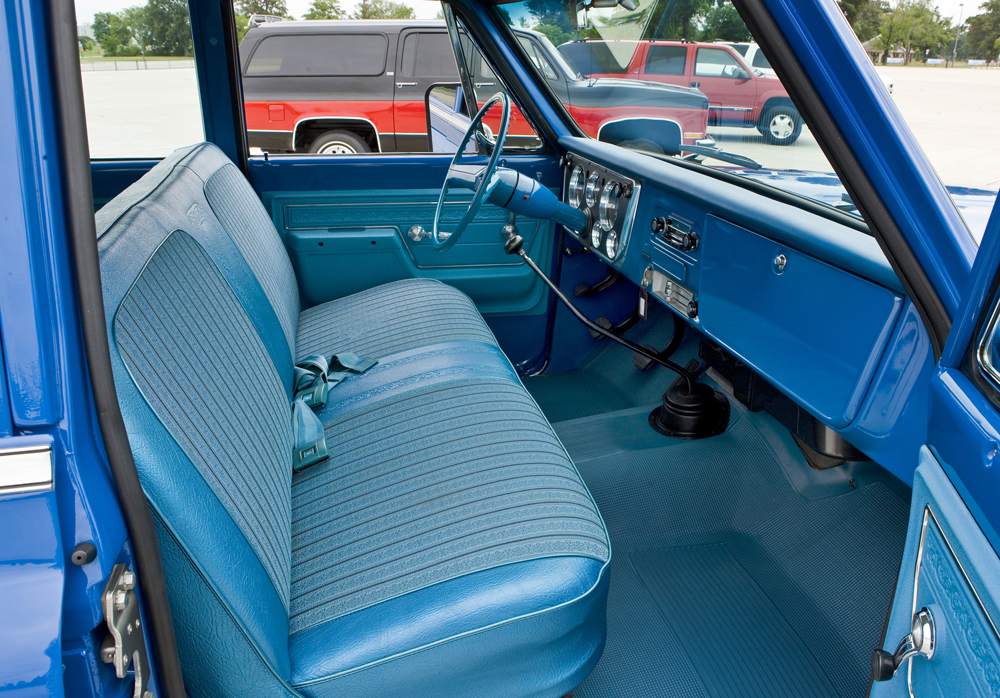
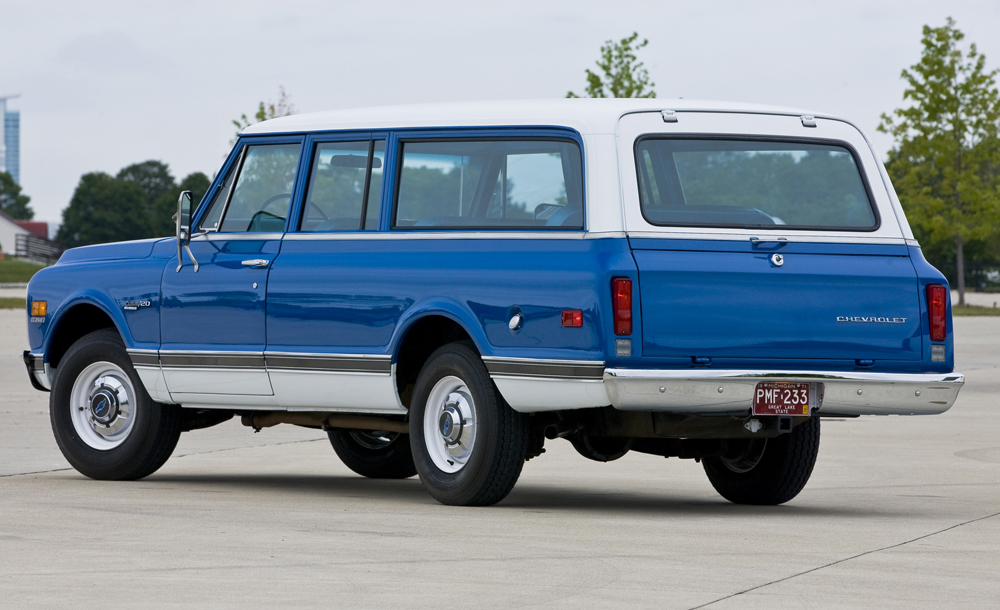

- 1973: A new generation of Chevy trucks is launched, with Suburban offered in a conventional four-door body style introduced for the first time. Its 129.5-inch (3,289 mm) wheelbase was only 0.5-inch (12.7 mm) shorter than the 2010 model’s. Also debuting is the Suburban three-quarter-ton model, which could be had with a 454 big-block engine that delivered 335 lb.-ft. of torque (455 Nm).
- 1975: Increased focus on interior comfort and amenities in the 1973 models bring more customers to Suburban for use as a personal vehicle. Chevrolet responds with more comfortable seats and greater amenities, including simulated buffalo hide vinyl upholstery, wood grain dash inserts, fully trimmed door panels and more. NEW TECHNOLOGY: Rubber front control arm bushings and new rear leaf springs greatly improve ride quality.
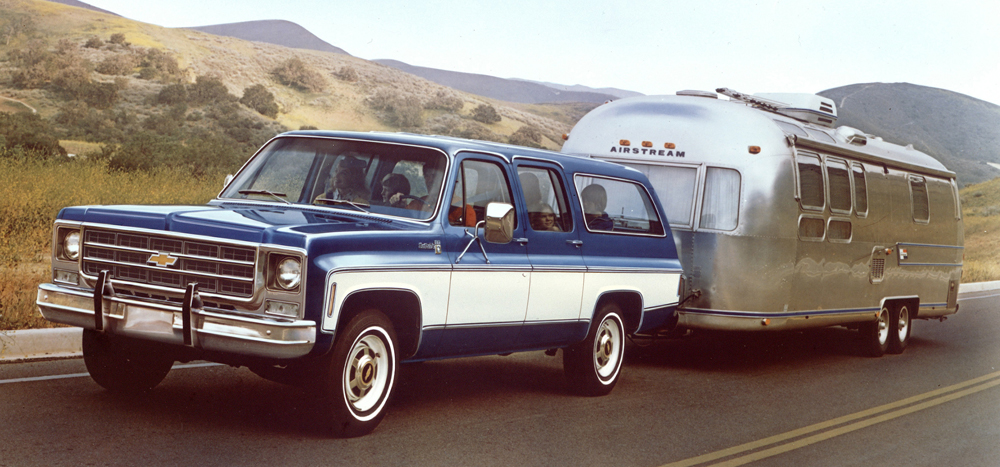
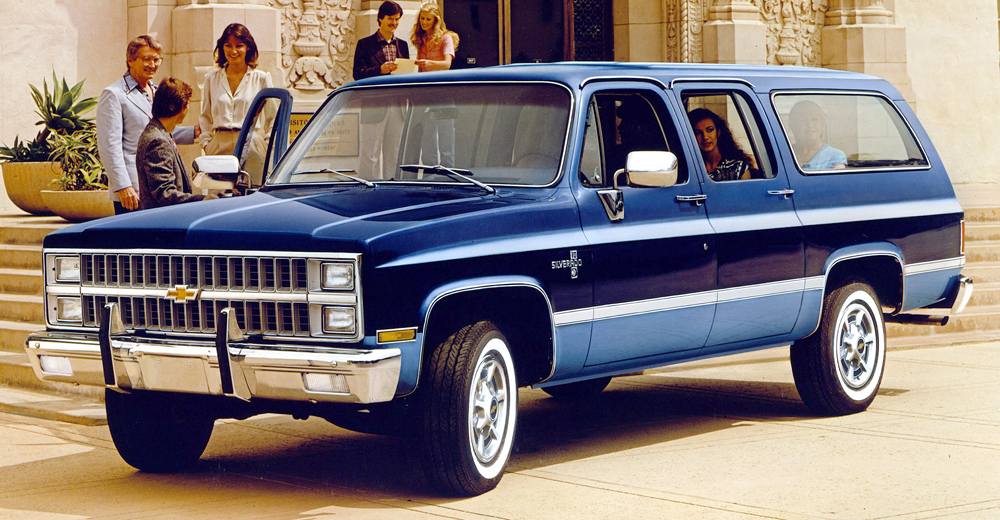
- 1981: Updated styling brings stacked rectangular headlamps for the 1980s. The 4WD system adds automatic locking hubs and the 454 big-block is still offered, giving customers great towing capability. New low-drag disc brakes enhanced fuel economy.
- 1987: Electronically controlled fuel injection and a four-speed overdrive transmission bring greater efficiency.
- 1988: Antilock brakes offered for the first time.
The Chevrolet Suburban hit the mainstream in the early 1980s, with the overall popularity of sport-utility vehicles. But while many customers were new to the Suburban then, it had garnered a legion of longtime owners who had purchased multiple examples over the years – using them to haul Little League teams and their equipment, tow a horse trailer or seat a work crew on the way to a job site.

1990 Chevrolet Suburban
A decade of change and, ultimately, prosperity opened in 1990, but it didn’t get off to a strong start. The United States was mired in a recession and Generation X, the post-Boomer demographic entering the workforce, found little opportunity upon graduation. It was a year that saw the collapse of the Soviet Union and Iraq’s invasion of Kuwait, which sparked the first Gulf War.
After weathering the tumultuous Seventies and go-go Eighties, the Chevrolet Suburban entered the Nineties on the leading edge of the SUV phenomenon that would soon change the definition of the family car in America. Although a new Suburban was on the drawing boards (based on the redesigned Chevy C/K trucks that were introduced in 1988), it was based on long, 129.5-inch wheelbase platform that launched in 1973.
It was a generation that brought fundamental changes to the Suburban, as a greater emphasis on comfort and more car-like driving characteristics in the half-ton models attracted more than just utility crews. More and more people were making the Suburban their personal vehicle, which could tow a horse trailer or camper on the weekends.
The gentrification of the Suburban grew in 1987 with the introduction of electronically controlled fuel injection and a fuel-saving four-speed overdrive automatic transmission. Anti-lock brakes were offered in 1988. By 1990, the base inline-6 engine that had been a staple of the Suburban lineup was long gone. A 5.7-liter small-block V-8 was standard and the 7.4L big-block was available for those who needed the ultimate in towing capability. Like the Suburban, the small-block and big-block engines had long histories of service: The small-block debuted in 1955 and the big-block in 1965.
The Chevrolet Suburban celebrated its 55th anniversary in 1990 – the year “The Simpsons” debuted. Both are still going strong.
1990 CHEVROLET SUBURBAN FACTS
Body style……………………………………………………..Four-door with “barn doors”
Wheelbase…………………………………………………….129.5 inches
Engine………………………………………………………….350-cubic-inch (5.7L) V-8
Horsepower……………………………………………………210 at 4,400 rpm
Torque…………………………………………………………300 lb.-ft. at 3,200 rpm
Transmission…………………………………………………..Four-speed automatic
Curb weight (approx.)………………………………………..4,500 pounds (2WD half-ton)
THE BOTTOM LINE: 1990 INCOME AND PRICES (with 2010 inflation conversions)
Chevrolet Suburban (base MSRP)…………………………..$15,615 ($26,741)
Median household income……………………………………$29,943 ($51,278)
Median house price…………………………………………..$92,000 ($157,552)
Cost of a gallon of regular gasoline…………………………$1.15 ($1.97)
Cost of a loaf of bread……………………………………….$0.55 ($0.94)
Cost of a movie ticket………………………………………..$4.22 ($7.23)
Average Major League Baseball salary……………………..$589,483 ($1,009,502)

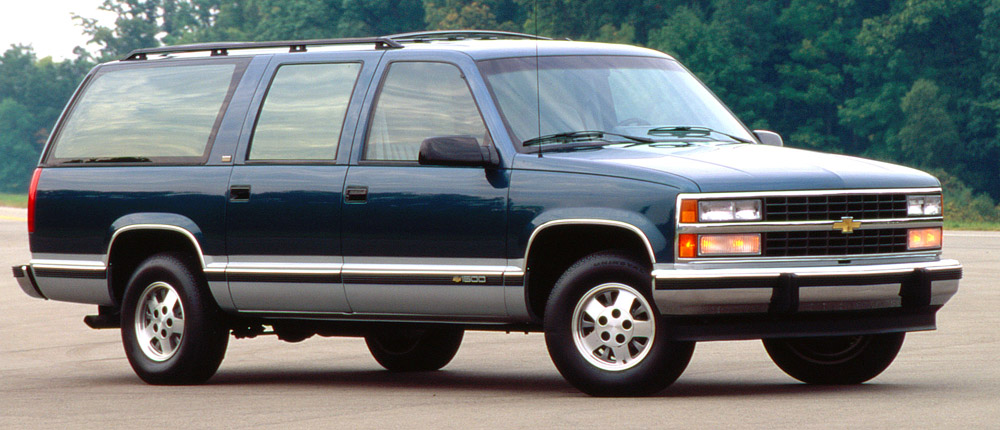
- 1992: An all-new Suburban features sleek styling with flush glass and composite headlamps. The 5.7L small-block V-8 powers 1500 models, while the 454 (7.4L) engine is still available in the 2500 series. Other updates include four-wheel anti-lock brakes for both 2WD and 4WD models, Insta-Trac on four-wheel-drive models and a new independent front suspension system designed to provide a more carlike ride.
- 1995: Driver-side air bag added.
- 1996: Push-button 4WD activation and daytime running lights debut.
- 1997: Passenger-side frontal air bag added.
- 1998: OnStar and the full-time AutoTrac all-wheel-drive system are added. In Australia, right-hand-drive versions of the Suburban are offered through GM’s Holden brand.

1999 Chevrolet Suburban
The uncertainty that greeted the Nineties, including the Gulf War and a recession, gave way to the most prosperous period of growth in American history. The Dow Jones Industrial average was at about 2,800 in June 1990, but soared to 11,750 in 1999. Unemployment was only 4.5 percent.
Americans’ love affair with SUVs ballooned in the Nineties and the Chevrolet Suburban was one of the most popular. The 1999 model was the final year for a generation introduced in 1992. It was the best Suburban generation to date, with a longer, 131.5-inch wheelbase, aerodynamic styling – including flush-mounted glass – and many of the same luxurious amenities typically reserved for premium sedans. Those features were backed up by robust Vortec powertrains, featuring the tried-and-true small-block and big-block V-8 engines. Advances in combustion technology and enhanced overdrive transmissions improved efficiency.
Because an all-new Suburban would be introduced for 2000, there were no significant updates with the ’99 model, but it offered a wide range of safety and convenience features that were introduced during the 1992-99 generation, including: Driver and passenger frontal airbags, AutoTrac all-wheel-drive system, Electronic variable-assist steering, Electronically controlled automatic transmission and OnStar
The ’99 Suburban retained its characteristic four-door body style and continued to offer access to the rear cargo area via a liftgate/tailgate configuration or the classic double “barn doors” that had been a Suburban staple since its inception in 1935.
Approximately 139,000 Suburbans were sold in 1999 – a 27-perecent increase over 1998 sales.
1999 CHEVROLET SUBURBAN FACTS
Body style……………………………………………………..Four-door with “barn doors”
Wheelbase……………………………………………………..131.5 inches
Engine………………………………………………………….350-cubic-inch (5.7L) V-8
Horsepower…………………………………………………….255 at 4,600 rpm
Torque………………………………………………………….330 lb.-ft. at 2,800 rpm
Transmission…………………………………………………..Four-speed automatic
Curb weight (approx.)………………………………………..4,780 pounds (2WD half-ton)
THE BOTTOM LINE: 1999 INCOME AND PRICES (with 2010 inflation conversions)
Chevrolet Suburban (base MSRP)…………………………..$25,775 ($33,960)
Median household income……………………………………$40,816 ($53,777)
Median house price…………………………………………..$148,200 ($195,263)
Cost of a gallon of regular gasoline…………………………$1.17 ($1.54)
Cost of a loaf of bread……………………………………….$1.49 ($1.96)
Cost of a movie ticket……………………………………….$5.06 ($6.67)
Average Major League Baseball salary……………………..$1,726,282 ($2,274,409)
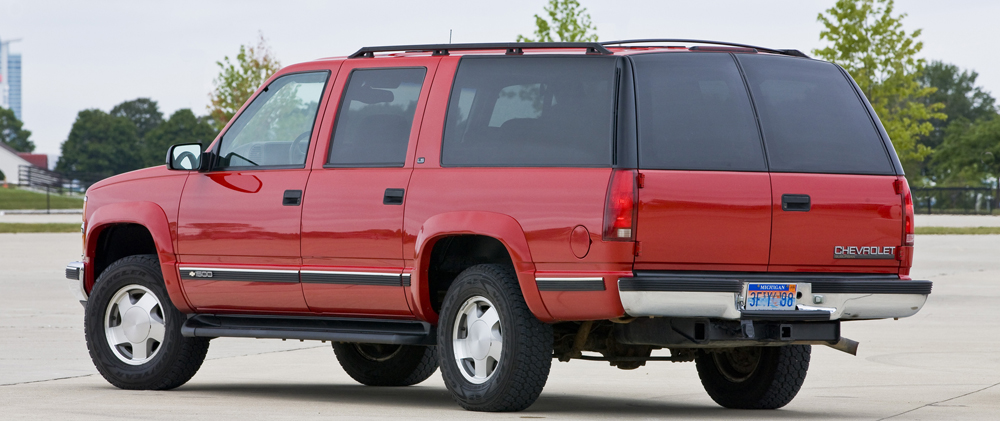
2000: Launched in 1999 as a 2000 model, the next-generation Suburban brings new styling, new interiors and new powertrains. The engines include the Vortec 5.3L and 6.0L V-8s that were from the same Gen III V-8 “LS” family that debuted a couple of years earlier as the LS1 in the Corvette. SAFETY FEATURES: Four-wheel disc brakes and a load-leveling suspension system.

You must be logged in to post a comment.